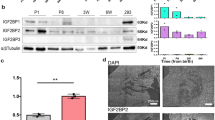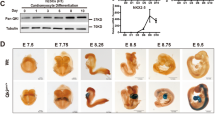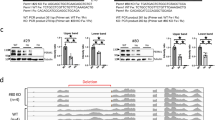Abstract
Cardiomyopathy is associated with altered expression of genes encoding contractile proteins. Here we show that Trbp (Tarbp2), an RNA-binding protein, is required for normal heart function. Cardiac-specific inactivation in mice of Trbp (TrbpcKO) caused progressive cardiomyopathy and lethal heart failure. Loss of Trbp function resulted in upregulation of Sox6, repression of genes encoding normal cardiac slow-twitch myofiber proteins and pathologically increased expression of genes encoding skeletal fast-twitch myofiber proteins. Remarkably, knockdown of Sox6 fully rescued the Trbp-mutant phenotype, whereas mice overexpressing Sox6 phenocopied TrbpcKO mice. Trbp inactivation was mechanistically linked to Sox6 upregulation through altered processing of miR-208a, which is a direct inhibitor of Sox6. Transgenic overexpression of Mir208a sufficiently repressed Sox6, restored the balance in gene expression for fast- and slow-twitch myofiber proteins, and rescued cardiac function in TrbpcKO mice. Together, our studies identify a new Trbp-mediated microRNA-processing mechanism in the regulation of a linear genetic cascade essential for normal heart function.
This is a preview of subscription content, access via your institution
Access options
Subscribe to this journal
Receive 12 print issues and online access
$209.00 per year
only $17.42 per issue
Buy this article
- Purchase on Springer Link
- Instant access to full article PDF
Prices may be subject to local taxes which are calculated during checkout






Similar content being viewed by others
Accession codes
References
Feng, H.-Z. & Jin, J.-P. Coexistence of cardiac troponin T variants reduces heart efficiency. Am. J. Physiol. Heart Circ. Physiol. 299, H97–H105 (2010).
Kimber, E., Tajsharghi, H., Kroksmark, A.-K., Oldfors, A. & Tulinius, M. A mutation in the fast skeletal muscle troponin I gene causes myopathy and distal arthrogryposis. Neurology 67, 597–601 (2006).
Laing, N.G. et al. A mutation in the α tropomyosin gene TPM3 associated with autosomal dominant nemaline myopathy. Nat. Genet. 9, 75–79 (1995).
Landstrom, A.P. et al. Molecular and functional characterization of novel hypertrophic cardiomyopathy susceptibility mutations in TNNC1-encoded troponin C. J. Mol. Cell. Cardiol. 45, 281–288 (2008).
Mogensen, J. et al. Severe disease expression of cardiac troponin C and T mutations in patients with idiopathic dilated cardiomyopathy. J. Am. Coll. Cardiol. 44, 2033–2040 (2004).
Olson, T.M., Karst, M.L., Whitby, F.G. & Driscoll, D.J. Myosin light chain mutation causes autosomal recessive cardiomyopathy with mid-cavitary hypertrophy and restrictive physiology. Circulation 105, 2337–2340 (2002).
Tajsharghi, H., Ohlsson, M., Lindberg, C. & Oldfors, A. Congenital myopathy with nemaline rods and cap structures caused by a mutation in the β-tropomyosin gene (TPM2). Arch. Neurol. 64, 1334–1338 (2007).
Yu, Z.-B., Wei, H. & Jin, J.-P. Chronic coexistence of two troponin T isoforms in adult transgenic mouse cardiomyocytes decreased contractile kinetics and caused dilatative remodeling. Am. J. Physiol. Cell Physiol. 303, C24–C32 (2012).
Petchey, L.K. et al. Loss of Prox1 in striated muscle causes slow to fast skeletal muscle fiber conversion and dilated cardiomyopathy. Proc. Natl. Acad. Sci. USA 111, 9515–9520 (2014).
Mendell, J.T. & Olson, E.N. MicroRNAs in stress signaling and human disease. Cell 148, 1172–1187 (2012).
Small, E.M. & Olson, E.N. Pervasive roles of microRNAs in cardiovascular biology. Nature 469, 336–342 (2011).
Bartel, D.P. & Chen, C.-Z. Micromanagers of gene expression: the potentially widespread influence of metazoan microRNAs. Nat. Rev. Genet. 5, 396–400 (2004).
van Rooij, E. et al. Control of stress-dependent cardiac growth and gene expression by a microRNA. Science 316, 575–579 (2007).
Chen, J.-F. et al. Targeted deletion of Dicer in the heart leads to dilated cardiomyopathy and heart failure. Proc. Natl. Acad. Sci. USA 105, 2111–2116 (2008).
Liu, N. et al. microRNA-133a regulates cardiomyocyte proliferation and suppresses smooth muscle gene expression in the heart. Genes Dev. 22, 3242–3254 (2008).
Callis, T.E. et al. MicroRNA-208a is a regulator of cardiac hypertrophy and conduction in mice. J. Clin. Invest. 119, 2772–2786 (2009).
van Rooij, E. et al. A family of microRNAs encoded by myosin genes governs myosin expression and muscle performance. Dev. Cell 17, 662–673 (2009).
Heidersbach, A. et al. microRNA-1 regulates sarcomere formation and suppresses smooth muscle gene expression in the mammalian heart. eLife 2, e01323 (2013).
Zhao, Y., Samal, E. & Srivastava, D. Serum response factor regulates a muscle-specific microRNA that targets Hand2 during cardiogenesis. Nature 436, 214–220 (2005).
Zhao, Y. et al. Dysregulation of cardiogenesis, cardiac conduction, and cell cycle in mice lacking miRNA-1-2. Cell 129, 303–317 (2007).
Morton, S.U. et al. microRNA-138 modulates cardiac patterning during embryonic development. Proc. Natl. Acad. Sci. USA 105, 17830–17835 (2008).
Shieh, J.T., Huang, Y., Gilmore, J. & Srivastava, D. Elevated miR-499 levels blunt the cardiac stress response. PLoS ONE 6, e19481 (2011).
Huang, Z.P. et al. microRNA-22 regulates cardiac hypertrophy and remodeling in response to stress. Circ. Res. 112, 1234–1243 (2013).
Seok, H.Y. et al. Loss of microRNA-155 protects the heart from pathological cardiac hypertrophy. Circ. Res. 114, 1585–1595 (2014).
Chen, J. et al. mir-17-92 cluster is required for and sufficient to induce cardiomyocyte proliferation in postnatal and adult hearts. Circ. Res. 112, 1557–1566 (2013).
Gatignol, A., Buckler, C. & Jeang, KT. Relatedness of an RNA-binding motif in human immunodeficiency virus type 1 TAR RNA-binding protein TRBP to human P1/dsI kinase and Drosophila staufen. Mol. Cell. Biol. 13, 2193–2202 (1993).
Gatignol, A., Buckler-White, A., Berkhout, B. & Jeang, K.-T. Characterization of a human TAR RNA-binding protein that activates the HIV-1 LTR. Science 251, 1597–1600 (1991).
Chendrimada, T.P. et al. TRBP recruits the Dicer complex to Ago2 for microRNA processing and gene silencing. Nature 436, 740–744 (2005).
Haase, A.D. et al. TRBP, a regulator of cellular PKR and HIV-1 virus expression, interacts with Dicer and functions in RNA silencing. EMBO Rep. 6, 961–967 (2005).
Fukunaga, R. et al. Dicer partner proteins tune the length of mature miRNAs in flies and mammals. Cell 151, 533–546 (2012).
Lee, H.Y. & Doudna, J.A. TRBP alters human precursor microRNA processing in vitro. RNA 18, 2012–2019 (2012).
Kim, Y. et al. Deletion of human tarbp2 reveals cellular microRNA targets and cell-cycle function of TRBP. Cell Rep. 9, 1061–1074 (2014).
Lakso, M. et al. Efficient in vivo manipulation of mouse genomic sequences at the zygote stage. Proc. Natl. Acad. Sci. USA 93, 5860–5865 (1996).
Zhong, J., Peters, A.H., Lee, K. & Braun, R.E. A double-stranded RNA binding protein required for activation of repressed messages in mammalian germ cells. Nat. Genet. 22, 171–174 (1999).
Jiao, K. et al. An essential role of Bmp4 in the atrioventricular septation of the mouse heart. Genes Dev. 17, 2362–2367 (2003).
Creemers, E.E., Wilde, A.A. & Pinto, Y.M. Heart failure: advances through genomics. Nat. Rev. Genet. 12, 357–362 (2011).
van Bilsen, M. & Chien, K.R. Growth and hypertrophy of the heart: towards an understanding of cardiac specific and inducible gene expression. Cardiovasc. Res. 27, 1140–1149 (1993).
Jiang, J., Wakimoto, H., Seidman, J.G. & Seidman, C.E. Allele-specific silencing of mutant Myh6 transcripts in mice suppresses hypertrophic cardiomyopathy. Science 342, 111–114 (2013).
Lin, Z. et al. Cardiac-specific YAP activation improves cardiac function and survival in an experimental murine MI model. Circ. Res. 115, 354–363 (2014).
Shin, C.H. et al. Modulation of cardiac growth and development by HOP, an unusual homeodomain protein. Cell 110, 725–735 (2002).
Trivedi, C.M., Cappola, T.P., Margulies, K.B. & Epstein, J.A. Homeodomain only protein x is down-regulated in human heart failure. J. Mol. Cell. Cardiol. 50, 1056–1058 (2011).
Trivedi, C.M. et al. Hopx and Hdac2 interact to modulate Gata4 acetylation and embryonic cardiac myocyte proliferation. Dev. Cell 19, 450–459 (2010).
Chen, F. et al. Hop is an unusual homeobox gene that modulates cardiac development. Cell 110, 713–723 (2002).
An, C.I., Dong, Y. & Hagiwara, N. Genome-wide mapping of Sox6 binding sites in skeletal muscle reveals both direct and indirect regulation of muscle terminal differentiation by Sox6. BMC Dev. Biol. 11, 59 (2011).
Quiat, D. et al. Concerted regulation of myofiber-specific gene expression and muscle performance by the transcriptional repressor Sox6. Proc. Natl. Acad. Sci. USA 108, 10196–10201 (2011).
Lee, L.W. et al. Complexity of the microRNA repertoire revealed by next-generation sequencing. RNA 16, 2170–2180 (2010).
Matkovich, S.J., Hu, Y. & Dorn, G.W. Regulation of cardiac microRNAs by cardiac microRNAs. Circ. Res. 113, 62–71 (2013).
De Vito, C. et al. A TARBP2-dependent miRNA expression profile underlies cancer stem cell properties and provides candidate therapeutic reagents in Ewing sarcoma. Cancer Cell 21, 807–821 (2012).
Huang, W., Sherman, B.T. & Lempicki, R.A. Systematic and integrative analysis of large gene lists using DAVID bioinformatics resources. Nat. Protoc. 4, 44–57 (2009).
Huang, W., Sherman, B.T. & Lempicki, R.A. Bioinformatics enrichment tools: paths toward the comprehensive functional analysis of large gene lists. Nucleic Acids Res. 37, 1–13 (2009).
Acknowledgements
We thank D. Clapham and members of the Wang laboratory for advice and support. We thank R. Espinoza-Lewis, G. Wang and F. Gu for technical support. We thank F.F. Wang for careful reading of the manuscript. Work in the Wang laboratory is supported by the March of Dimes Foundation, the Muscular Dystrophy Association and the US National Institutes of Health (HL085635 and HL116919). M.K. was supported by Banyu Life Science Foundation International.
Author information
Authors and Affiliations
Contributions
J.D. and D.-Z.W. conceived the project, designed the experiments, analyzed the data and wrote the manuscript. J.D. generated and characterized the Trbp-mutant mice and performed molecular biology experiments. J.D., L.M. and P.Z. contributed to targeting vector construction and Southern blotting. J.D. and J.C. contributed to echocardiographic data acquisition and analysis. Y.W. analyzed the RNA-seq data. J.D., X.H., M.N. and Z.-L.D. contributed to morphological and histological data acquisition and analysis. J.D., M.K. and Z.L. contributed to AAV preparation and administration. W.T.P. supervised AAV preparation and administration and reviewed the manuscript.
Corresponding author
Ethics declarations
Competing interests
The authors declare no competing financial interests.
Integrated supplementary information
Supplementary Figure 1 Generation of Trbp knockout mice.
(a) Schematic of the Trbp knockout strategy. (b) Southern blot and PCR assays to confirm the desired recombination events. (c) qRT-PCR of Trbp expression in the indicated organs of Trbp-null (Trbp−/−) and wild-type (WT) mice. n = 3; **P < 0.01. (d) Left, Kaplan-Meier survival curves of Trbp−/− and WT mice. Middle, gross morphology of 2-week-old Trbp−/− and WT mice. Right, body weight of 2-week-old Trbp−/− and WT (+/+) mice. n = 6; **P < 0.01.
Supplementary Figure 2 Expression of cell cycle markers in the heart.
qRT-PCR documenting the expression of the indicated cell cycle marker genes in the hearts of TrbpcKO and control mice at various stages. P2.5, postnatal day 2.5; 2wk, 2 weeks after birth; 1mo, 1 month after birth. n = 3; NS, not significant; *P < 0.05, **P < 0.01.
Supplementary Figure 3 Overexpression of Hopx fails to rescue the defects of TrbpcKO mice.
(a) Expression of Hopx in the hearts of 2-week-old TrbpcKO and control mice assayed with qRT-PCR. n = 3; **P < 0.01. (b) Western blot to detect Hopx and Trbp proteins in the hearts of 2-week-old mice. Gapdh served as a loading control. (c) Kaplan-Meier survival curves of control/AAV-Luc, TrbpcKO/AAV-Luc, Control/AAV-Hopx and TrbpcKO/AAV-Hopx (TrbpcKO/AAV-Luc versus TrbpcKO/AAV-Hopx, P > 0.05). (d) Left-ventricle internal dimension at systolic (LVID;s) and fractional shortening (FS%) of TrbpcKO and control mice after AAV-Hopx or AAV-Luc injection. n = 6–17; NS, not significant; **P < 0.01.
Supplementary Figure 4 Sox6 expression is regulated by Trbp in the heart.
(a) Expression of Sox6 in the hearts of TrbpcKO and control mice at the indicated time points. n = 3; *P < 0.05, **P < 0.01. (b) Expression of Sox6 in the hearts of 1-month-old TrbpcKO and control mice injected with AAV-Trbp or AAV-Luc control. n = 3; *P < 0.05, **P < 0.01. (c) Gross morphology and histology of heart samples from 1-month-old wild-type mice injected with AAV-Sox6 or AAV-Luc control. Scale bars, 1.0 mm.
Supplementary Figure 5 Expression of miR-208a and miR-499 in the heart.
(a) qRT-PCR of pre-miR-208a in the hearts of TrbpcKO and control mice at the indicated time points. n = 3; **P < 0.01. (b) Quantification of the expression of pre-miR-208a in the hearts of 1-month-old TrbpcKO and control mice injected with AAV-Trbp or AAV-Luc control. (c) Quantification of the expression of pre-miR-208a in the hearts of 1-month-old TrbpcKO and control mice injected with AAV-Sox6 or AAV-Luc control. (d) Quantification of the expression of pre-miR-208a in the hearts of 1-month-old TrbpcKO, control, miR-208aTG and TrbpcKO; miR-208aTG mice. (e) qRT-PCR of miR-499 in the hearts of 1-month-old TrbpcKO and control mice injected with AAV-Trbp or AAV-Luc control. n = 3; **P < 0.01.
Supplementary information
Supplementary Text and Figures
Supplementary Figures 1–5 and Supplementary Tables 1–7. (PDF 450 kb)
Rights and permissions
About this article
Cite this article
Ding, J., Chen, J., Wang, Y. et al. Trbp regulates heart function through microRNA-mediated Sox6 repression. Nat Genet 47, 776–783 (2015). https://doi.org/10.1038/ng.3324
Received:
Accepted:
Published:
Issue Date:
DOI: https://doi.org/10.1038/ng.3324
This article is cited by
-
Sox6, A Potential Target for MicroRNAs in Cardiometabolic Disease
Current Hypertension Reports (2022)
-
LncRNA LncHrt preserves cardiac metabolic homeostasis and heart function by modulating the LKB1-AMPK signaling pathway
Basic Research in Cardiology (2021)
-
Intercalated disc protein Xinβ is required for Hippo-YAP signaling in the heart
Nature Communications (2020)
-
Myricetin improves endurance capacity by inducing muscle fiber type conversion via miR-499
Nutrition & Metabolism (2019)
-
Therapeutic role of miR-19a/19b in cardiac regeneration and protection from myocardial infarction
Nature Communications (2019)



